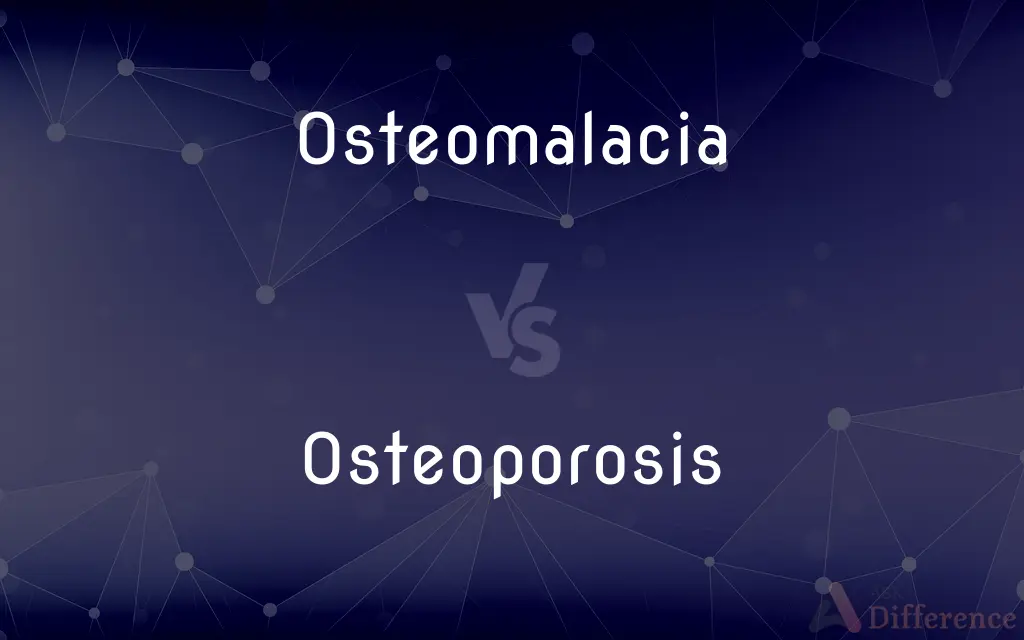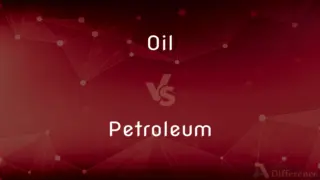Osteomalacia vs. Osteoporosis — What's the Difference?
Edited by Tayyaba Rehman — By Maham Liaqat — Updated on April 8, 2024
Osteomalacia involves the softening of bones due to vitamin D or mineral deficiency, affecting bone mineralization, whereas osteoporosis is characterized by decreased bone density and increased fragility, often due to aging.

Difference Between Osteomalacia and Osteoporosis
Table of Contents
ADVERTISEMENT
Key Differences
Osteomalacia results from a defect in the bone-building process, specifically the mineralization of bone tissue, leading to softer and weaker bones. This condition is often caused by a deficiency in vitamin D, calcium, or phosphate. On the other hand, osteoporosis is a condition that leads to porous bones, making them more susceptible to fractures. It primarily results from a loss of bone mass and density, often related to hormonal changes or deficiencies in calcium and vitamin D over time.
While osteomalacia affects the bone matrix's mineralization process, osteoporosis affects the bone density and structure. Osteomalacia can lead to bone pain and muscular weakness, indicating problems with bone mineralization, whereas osteoporosis may be asymptomatic until a bone fracture occurs, indicating weakened bones without affecting their mineralization.
Risk factors for osteomalacia include dietary deficiencies, certain medical conditions affecting vitamin D metabolism, and limited exposure to sunlight. Conversely, osteoporosis risk factors include age, gender (with women being more susceptible), genetic predisposition, and lifestyle choices such as smoking and excessive alcohol consumption.
Treatment for osteomalacia focuses on replenishing deficient minerals and vitamins, typically through supplements and diet. Osteoporosis treatment includes medications that slow bone loss, supplements to support bone health, and lifestyle changes to reduce fracture risk.
Comparison Chart
Definition
Softening of bones due to inadequate mineralization
Decrease in bone density and increase in fragility
ADVERTISEMENT
Causes
Vitamin D, calcium, or phosphate deficiency
Aging, hormonal changes, calcium/vitamin D deficiency
Symptoms
Bone pain, muscle weakness
Often asymptomatic, fractures
Risk Factors
Dietary deficiencies, lack of sunlight, certain medical conditions
Age, gender, genetics, lifestyle choices
Treatment
Vitamin and mineral supplements, diet
Medications to slow bone loss, supplements, lifestyle changes
Compare with Definitions
Osteomalacia
Results in a higher risk of fractures and deformities.
Osteomalacia can cause bone deformities such as bowed legs in youngs.
Osteoporosis
Managed through medications and lifestyle changes.
Medications that prevent bone loss and exercises that improve bone strength are key to managing osteoporosis.
Osteomalacia
Treated with supplements and diet modifications.
Treating osteomalacia involves high doses of vitamin D and calcium supplements.
Osteoporosis
Characterized by decreased bone mass and density.
Bone density scans can show significant loss in bone mass, indicative of osteoporosis.
Osteomalacia
Caused by deficiencies in vitamin D, calcium, or phosphate.
Lack of sunlight exposure can result in vitamin D deficiency, causing osteomalacia.
Osteoporosis
Asymptomatic until a fracture occurs.
Many people are unaware they have osteoporosis until they suffer a minor fall that results in a fracture.
Osteomalacia
Osteomalacia is a disease characterized by the softening of the bones caused by impaired bone metabolism primarily due to inadequate levels of available phosphate, calcium, and vitamin D, or because of resorption of calcium. The impairment of bone metabolism causes inadequate bone mineralization.
Osteoporosis
A condition where bones become brittle and fragile.
Osteoporosis increases the risk of fractures, especially in the hip, spine, and wrist.
Osteomalacia
A disease of the bones, in which they lose their earthy material, and become soft, flexible, and distorted. Also called malacia.
Osteoporosis
Often related to aging and hormonal changes.
Postmenopausal women are at a higher risk of developing osteoporosis due to estrogen decline.
Osteomalacia
Abnormal softening of bones caused by deficiencies of phosphorus or calcium or vitamin D
Osteoporosis
Osteoporosis is a systemic skeletal disorder characterized by low bone mass, micro-architectural deterioration of bone tissue leading to bone fragility, and consequent increase in fracture risk. It is the most common reason for a broken bone among the elderly.
Osteoporosis
A disease characterized by a decrease in bone mass and density, occurring especially in postmenopausal women, resulting in a predisposition to fractures.
Osteoporosis
(pathology) A disease, occurring especially in women following menopause, in which the bones become extremely porous and are subject to fracture.
Osteoporosis
An absorption of bone so that the bone tissue becomes unusually porous. It occurs especially in elderly men and postmenopausal women, and predisposes the elderly to fractures of the bones.
Osteoporosis
Abnormal loss of bony tissue resulting in fragile porous bones attributable to a lack of calcium; most common in postmenopausal women
Common Curiosities
Is osteoporosis more common in men or women?
Osteoporosis is more common in women, especially postmenopausal women, due to the rapid decline in estrogen levels which affects bone density.
What is the main difference between osteomalacia and osteoporosis?
The main difference lies in their causes and effects; osteomalacia is due to bone softening from inadequate mineralization, while osteoporosis involves reduced bone density and increased fragility.
Are osteomalacia and osteoporosis preventable?
Both conditions can be partly preventable with a healthy lifestyle, including adequate intake of calcium and vitamin D, regular exercise, and minimizing risk factors like smoking and excessive alcohol consumption.
What are the treatment options for osteomalacia and osteoporosis?
Osteomalacia treatment focuses on vitamin and mineral supplementation. Osteoporosis treatment includes medications to slow bone loss, supplements, and lifestyle adjustments.
Can osteomalacia lead to osteoporosis?
Yes, if osteomalacia is left untreated, the weakened bones can contribute to the development of osteoporosis over time.
What are the long-term effects of osteomalacia and osteoporosis?
Without treatment, both conditions can lead to increased risk of fractures, chronic pain, and in severe cases, disability.
Can diet and exercise improve osteomalacia and osteoporosis?
Yes, a diet rich in calcium and vitamin D, along with regular weight-bearing exercises, can improve both conditions and help maintain healthy bones.
How does aging affect the risk of developing osteoporosis?
Aging can lead to a decrease in bone density and mass, increasing the risk of osteoporosis, especially in individuals who have a lower peak bone mass during their youth.
Can children develop osteomalacia or osteoporosis?
Children can develop a condition similar to osteomalacia known as rickets, which affects bone development. Osteoporosis is rare in children but can occur, especially due to underlying health conditions.
Is sunlight exposure related to osteomalacia and osteoporosis?
Yes, sunlight exposure is important for vitamin D synthesis in the skin, which is crucial for bone health, helping to prevent both osteomalacia and osteoporosis.
Are there specific foods that can help prevent osteomalacia and osteoporosis?
Foods rich in calcium (like dairy products, green leafy vegetables) and those high in vitamin D (such as fatty fish and fortified foods) can help prevent these conditions.
Share Your Discovery

Previous Comparison
Lesson vs. Chapter
Next Comparison
Oil vs. PetroleumAuthor Spotlight
Written by
Maham LiaqatEdited by
Tayyaba RehmanTayyaba Rehman is a distinguished writer, currently serving as a primary contributor to askdifference.com. As a researcher in semantics and etymology, Tayyaba's passion for the complexity of languages and their distinctions has found a perfect home on the platform. Tayyaba delves into the intricacies of language, distinguishing between commonly confused words and phrases, thereby providing clarity for readers worldwide.














































